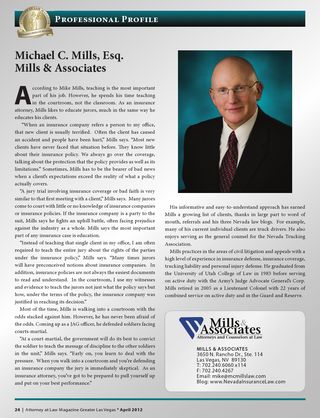 Nevada follows the rule that a Plaintiff may not file two separate suits arising from the same set of facts. The consequence of trying to split causes of action is that if requirements of the rule are satisfied, the second suit will be dismissed.
Nevada follows the rule that a Plaintiff may not file two separate suits arising from the same set of facts. The consequence of trying to split causes of action is that if requirements of the rule are satisfied, the second suit will be dismissed.
The Nevada Supreme Court said:
As a general proposition, a single cause of action may not be split and separate actions maintained. Reno Club v. Harrah Et Al., 70 Nev. 125, 260 P.2d 304 (1953). The wrongful act of the defendant creates the plaintiff’s cause of action. Policy demands that all forms of injury or damage sustained by the plaintiff as a consequence of the defendant’s wrongful act be recovered in one action rather than in multiple actions. Concomitantly, the single cause of action rule bars one who has sustained personal injury and property loss from the same cause and who has prosecuted to judgment a suit for either of his two elements of damage from thereafter suing to recover the remaining element. The great weight of authority supports the single cause of action rule when the plaintiff in each case is the same person. Cases collected Annot. 62 ALR2d 977 (1958).
Smith v. Hutchins, 93 Nev. 431, 432-33, 566 P.2d 1136, 1137 (1977).
This doctrine of claim preclusion is explained in the case of Five Star Capital Corp. v. Ruby, 124 Nev. 1048, 1056-57, 194 P.3d 709, 714 (2008)
for claim preclusion to apply the following factors must be met:
(1) the same parties or their privies are involved in both cases,
(2) a valid final judgment has been entered, and
(3) the subsequent action is based on the same claims or any part of them that were or could have been brought in the first case.
The Court goes on to explain the reasoning behind the rule. It said:
This is the exact type of case for which claim preclusion is necessary–to prevent a party from continually filing additional lawsuits until it obtains the outcome it desires by merely asserting an additional claim for relief.
Id. at 1060, 194 P.3d at 716.
In the Smith case the first element of claims preclusion was not met. While there were two separate actions, the first suit in Smith was a subrogation action filed by Smith’s insurance company. The Court said that under that circumstance, the requirements of the rule were not met even though the subrogation suit had been resolved.
However, the outcome was not so favorable to Plaintiff in the case of Charles v. Old Republic Title Co., 130 Nev. 1163 (Unpub. 2014).
Mr. Charles, acting in proper person, filed a tort claim in the Justice Court which he lost. He then filed a contract claim in District Court which he dismissed. Later, he hired a lawyer who brought a second breach of contract action for the same transaction that he had earlier lost in the Justice Court. The Nevada Supreme Court told Mr. Charles that he should have brought all of the causes of action in the first suit.
Appellant further asserts that after he filed his justice court tort action, he filed a separate district court action that raised contract claims and that the district court action was later dismissed without prejudice, which cannot serve as a basis for claim preclusion. On this point appellant argues that it was improper to apply claim preclusion to his contract claims in this second district court action based on resolution of the justice court action. We reject this contention, as the justice court case was filed first and appellant could have raised his contract-based claims in that case; the fact that he improperly split his claims between two different earlier court proceedings does not prevent application of claim preclusion in this later proceeding.
Charles v. Old Republic Title Co., 130 Nev. 1163 (2014)
If you have questions about Nevada Coverage Law or Insurance Law in Nevada, please contact Mike Mills at 702.240.6060×114 or email him at mmills@blwmlawfirm.com.
 Follow
Follow Email
Email


